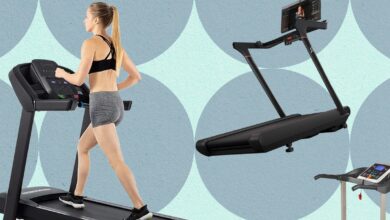Does Using Resistance Bands ‘Count’ as Strength Training?

All products are independently selected by our editors. If you buy something, we may earn an affiliate commission.
Let’s face it: It’s a whole lot easier to pick up a resistance band than it is to lug a set of dumbbells or kettlebells back to your bench. These exercise tools are incredibly lightweight—part of what makes them a convenient way to work out at home or while traveling—but given their lack of heft, it’s only natural to wonder: Do resistance bands “count” as strength training?
Can you, for example, swap out your free weights for a pack of bands and get the same exact perks? After all, you can do a bunch of the same exercises with both, like deadlifts, squats, and rows, to name a few. Or should they be considered more of an accessory tool?
We tapped fitness experts to understand what resistance bands can—and can’t—do for your strength goals, plus tips for incorporating these bendy devices in your gym routine.
Resistance bands can build strength…up to a point.
Before we dig into whether resistance bands qualify as strength training, let’s get clear on what we mean by that term. Basically, strength training is anything that applies tension to your muscles so that they can adapt and get stronger over time, Susie Reiner, PhD, CSCS, certified exercise physiologist and post doctoral researcher at the University of Kentucky’s Sports Medicine Research Institute, tells SELF.
By that criteria, resistance bands can certainly meet the mark, Dr. Reiner says.
As exercise physiologist Heather Hart, CSCS, explains it, the whole way we progress with strength training is through the principle of overload. That basically means that in order to see continued gains, “we have to provide our muscle with a resistance greater than what it is already adapted to,” she tells SELF. And for some people—especially beginner exercisers, folks who don’t strength train often, or those who have weaknesses in certain areas—using resistance bands can “absolutely” qualify as overload, helping you build bigger and stronger muscles, she explains. In fact, a 2019 meta-analysis of eight studies concluded that using resistance bands provided similar strength gains compared to weight machines and dumbbells.
But there’s an asterisk. These benefits, Dr. Reiner says, only last “up to a point.” That’s because once you gain a certain level of fitness, resistance bands won’t make the cut.
“You’re going to get to a point where the resistance band can only offer so much resistance against your muscles, and you’ve already adapted to that amount,” Hart explains. And for most people who regularly strength train, “you’re gonna hit at the top end of what you’re able to do with resistance bands probably pretty quickly,” Hart says. Though you absolutely can level up the challenge of resistance bands by choosing a thicker one—just like you can trade your 15-pound dumbbells for a pair of 20-pounders—there are fewer options for progression bands compared to free weights, so you’ll hit the ceiling at some point (unlike with free weights, where the options are pretty much endless.) Simply put, before long, the bands will no longer provide the challenge your muscles need to grow bigger and stronger.
But resistance bands do offer some advantages over traditional free weights.
Bands use a specific type of load called variable resistance, or accommodating resistance, Dr. Reiner explains. This means that the tension applied to your muscles changes throughout the range of motion. “It’s a different stimulus than traditional weight training, which is a constant load across the range of motion,” she says. The shifting resistance of bands provides a “new challenge” to your neuromuscular system, Dr. Reiner explains, which can offer some pretty great perks.
In some banded exercises, the resistance is heaviest when your muscles are at their strongest range of motion, and lightest when your muscles are at their weakest, Dr. Reiner explains. Take the squat, for example: The band is the most taut at the top of the squat—the portion of the move where people tend to be the strongest—and, vice versa, has the most slack at the bottom, where people are most likely to struggle, Dr. Reiner says. Same goes for the bench press: The band is loosest at the bottom of the move, which is typically the most difficult for people, and becomes tight as you reach the top of the exercise, where people tend to have the most strength. This match-up can be “very helpful” psychologically, Dr. Reiner explains, since you won’t be challenged as much at your weakest points. And it can help boost your power, too, she adds.
In other exercises—like a row or pull-down, for example—the resistance is flip-flopped: It’s heaviest when your muscles are at their weakest, and lightest at their strongest point, which is also a plus as it can help you progress through your strength training by working on the point where you struggle the most, Dr. Reiner explains.
What’s more, bands are an “excellent way” to ease into strength training or rehab from injury, Dr. Reiner says. That’s because they create a slower progression compared to weights, since you can make exercises more challenging in smaller increments by simply shortening the length of the band (versus picking up the next set of weights, which may be several pounds or more heavier.) “You can inch your way toward full-on strength training that way,” Dr. Reiner says. Plus, in a rehab (or prehab) scenario, you can use them to isolate specific muscle groups and work in different planes of motion simply by changing your position to the band, Dr. Reiner explains, which can be an easy, effective way to pinpoint specific areas.
They’re also stellar for getting in some form of strength work when you have limited access to other equipment, she adds, like those times when you just can’t make it to the gym after work or are traveling with no weights at your disposal.
To boot, bands are budget-friendly (you can buy a five-pack on Amazon for $24), portable (just toss ’em in your gym bag or suitcase), and highly versatile (they work with tons of different exercises—from traditional strength moves like lunges, bridges, and presses to more stability-focused exercises like pull-aparts, clamshells, and lateral walks).
Lastly, the fact that they’re basically just oversized rubber bands can make them less intimidating compared to a bulky set of free weights. “It’s a lot less scary to look at a resistance band than a dumbbell,” Hart says, which can make them a more approachable tool for anyone new to, or otherwise overwhelmed by, strength training.
But there are some downsides worth knowing about too.
Besides the fact that bands can only provide strength training to a point, making them a not-so-great-choice if your goal is heavy gains, their shifting resistance level could hinder your strength gains through your full range of motion, if you’re relying on bands alone and no weights, Dr. Reiner says.
Another con: With bands, “there’s no way to know that you’re actually getting the resistance you think you are,” Hart says. That’s because they’re often labeled with a range of resistance (versus one specific number) and over time, the material can stretch and degrade—all of which can make it tricky to track exactly how much heft you’re working with. This can make things murky if you’re striving for progressive overload. Plus, bands are way less durable than free weights, making them something you may have to replace on the reg. Not to mention having one pop or snap on you can be a pretty jarring experience!
All in all, resistance bands can be an awesome addition to really anyone’s routine.
There are instances where using resistance bands can “tick the box” for strength training, Dr. Reiner says, especially if you’re a beginner or building back your fitness after an injury or time off. And there are others where it acts more as a supplement alongside traditional weights, she adds.
Even if you reach a point where resistance bands don’t cut it as your strength work, there’s still a worthwhile spot for them in your routine. They’re great for things like mobility work, warm-ups, and both rehab and prehab exercises, Hart says. And, for people who regularly weight train, they’re a nice way to still get in a workout on those days when you’re a little more fatigued than usual or you simply don’t have the time to make it to the gym but have a pack of bands lying around at home, Dr. Reiner adds.
As Hart sums it up: No matter your goals or current strength abilities, “there’s always a place” for them in your routine. So consider adding a band (or 10!) to your arsenal of exercise tools. Even if they’re not ticking your box for strength work, they still have a lot to offer.
Related:
- Does Rowing ‘Count’ as Strength Training?
- 3 Things to Do If You’re Brand New to Strength Training and Feel Overwhelmed
- Does Indoor Cycling ‘Count’ as Strength Training—or Is It Just Cardio?
Get more of SELF’s great fitness coverage delivered right to your inbox—for free.



